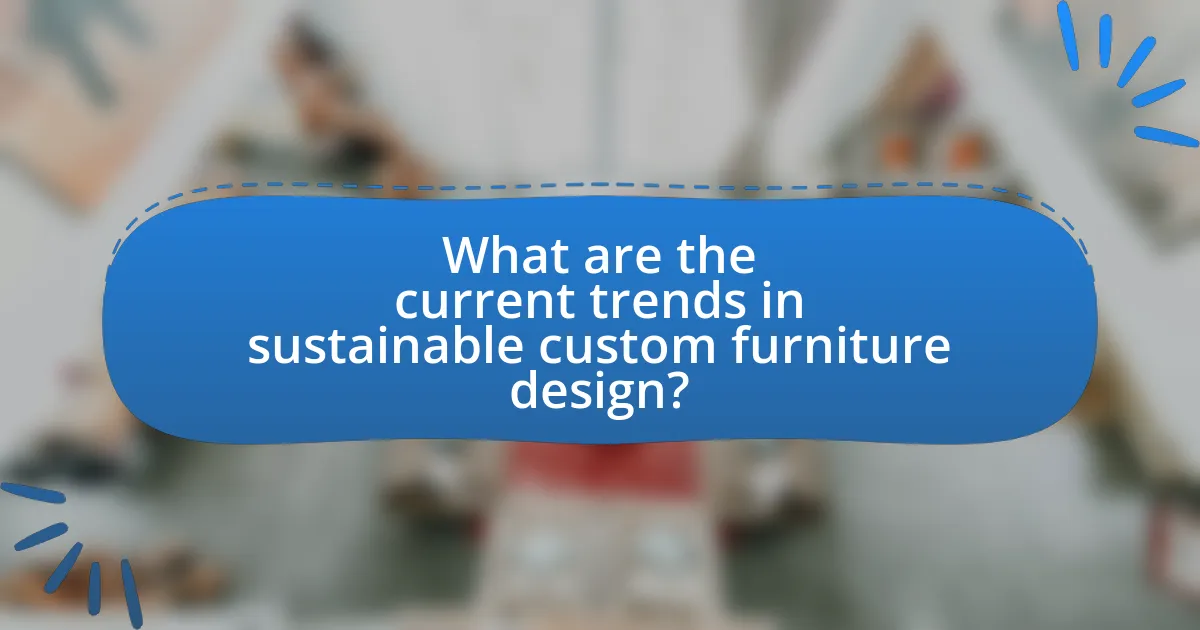The article focuses on current trends in sustainable custom furniture design, highlighting the increasing use of reclaimed materials, eco-friendly finishes, and modular designs that enhance longevity and adaptability. It defines sustainability in this context as minimizing environmental impact through responsible sourcing and efficient manufacturing processes. Key sustainable materials include reclaimed wood, bamboo, cork, and recycled metals, which significantly reduce waste and promote resource conservation. The article also explores consumer behaviors driving the demand for sustainable furniture, the role of technology and innovative techniques in design, and the challenges designers face in balancing cost and sustainability. Additionally, it provides practical tips for consumers to identify truly sustainable furniture options and questions to ask designers regarding their sustainability practices.

What are the current trends in sustainable custom furniture design?
Current trends in sustainable custom furniture design include the use of reclaimed materials, eco-friendly finishes, and modular designs that promote longevity and adaptability. Reclaimed wood and recycled metals are increasingly favored for their minimal environmental impact, while non-toxic finishes ensure healthier indoor air quality. Additionally, modular furniture allows for easy reconfiguration and repair, reducing waste and extending the product lifecycle. These trends reflect a growing consumer demand for environmentally responsible choices in home furnishings, supported by research indicating that 66% of consumers are willing to pay more for sustainable products.
How is sustainability defined in the context of custom furniture design?
Sustainability in the context of custom furniture design is defined as the practice of creating furniture that minimizes environmental impact through the use of eco-friendly materials, responsible sourcing, and efficient manufacturing processes. This approach emphasizes the importance of using renewable resources, such as sustainably harvested wood, and non-toxic finishes to reduce harm to both the environment and human health. Additionally, sustainable custom furniture design often incorporates principles of durability and longevity, ensuring that pieces are built to last, thereby reducing waste over time.
What materials are considered sustainable for custom furniture?
Sustainable materials for custom furniture include reclaimed wood, bamboo, cork, and recycled metals. Reclaimed wood is sourced from old buildings or furniture, reducing the need for new timber and preserving forests. Bamboo is a fast-growing grass that can be harvested without killing the plant, making it a renewable resource. Cork is harvested from the bark of cork oak trees, which regenerate, allowing for sustainable harvesting. Recycled metals, such as aluminum and steel, reduce the environmental impact of mining and processing new materials. These materials contribute to eco-friendly furniture design by minimizing waste and promoting resource conservation.
How does the choice of materials impact the environment?
The choice of materials significantly impacts the environment by influencing resource consumption, waste generation, and ecological footprints. Sustainable materials, such as reclaimed wood or bamboo, reduce deforestation and promote biodiversity, while conventional materials like plastic and non-recycled metals contribute to pollution and habitat destruction. For instance, the production of one ton of plastic generates approximately 3 tons of greenhouse gases, highlighting the environmental cost of using non-sustainable materials. Additionally, the lifecycle of materials, from extraction to disposal, determines their overall environmental impact, with sustainable options often resulting in lower emissions and reduced landfill contributions.
Why is sustainable custom furniture design gaining popularity?
Sustainable custom furniture design is gaining popularity due to increasing consumer awareness of environmental issues and a desire for personalized, eco-friendly products. As more individuals prioritize sustainability in their purchasing decisions, the demand for furniture made from responsibly sourced materials and designed to minimize waste has surged. According to a 2021 survey by the Furniture Today, 70% of consumers expressed a preference for sustainable products, highlighting a significant shift in consumer behavior towards eco-conscious choices. This trend is further supported by the rise of certifications and standards for sustainable materials, making it easier for consumers to identify and choose environmentally friendly options.
What consumer behaviors are driving this trend?
Consumer behaviors driving the trend in sustainable custom furniture design include a growing preference for eco-friendly materials and a desire for personalized, unique products. This shift is evidenced by a 2021 survey from McKinsey, which found that 67% of consumers consider sustainability when making a purchase, indicating a significant demand for environmentally responsible options. Additionally, the rise of social media platforms has led consumers to seek distinctive, custom pieces that reflect their individual style, further fueling the trend towards sustainable design.
How do sustainable practices enhance brand reputation?
Sustainable practices enhance brand reputation by demonstrating a commitment to environmental responsibility and ethical sourcing. Companies that adopt sustainable methods often attract environmentally conscious consumers, leading to increased customer loyalty and positive brand perception. For instance, a 2021 Nielsen report found that 73% of millennials are willing to pay more for sustainable brands, indicating that sustainability can significantly influence purchasing decisions. Furthermore, brands that prioritize sustainability often receive favorable media coverage, which can enhance visibility and credibility in the market.

What innovative techniques are being used in sustainable custom furniture design?
Innovative techniques in sustainable custom furniture design include the use of reclaimed materials, advanced digital fabrication methods, and eco-friendly finishes. Reclaimed materials, such as salvaged wood and metal, reduce waste and lower the carbon footprint associated with new material production. Advanced digital fabrication methods, like CNC machining and 3D printing, allow for precise designs that minimize material waste and enable customization. Eco-friendly finishes, including water-based and low-VOC (volatile organic compounds) options, enhance sustainability by reducing harmful emissions. These techniques collectively contribute to a more sustainable approach in the furniture design industry.
How are designers incorporating technology into sustainable practices?
Designers are incorporating technology into sustainable practices by utilizing advanced materials, digital fabrication, and smart design tools. For instance, the use of computer-aided design (CAD) software allows designers to optimize material usage, reducing waste during the production process. Additionally, technologies like 3D printing enable the creation of complex structures with minimal material, further enhancing sustainability. Research indicates that the adoption of eco-friendly materials, such as recycled plastics and sustainably sourced wood, is on the rise, with a 2021 study showing that 70% of designers prioritize sustainable materials in their projects. This integration of technology not only improves efficiency but also aligns with the growing consumer demand for environmentally responsible products.
What role does 3D printing play in sustainable furniture design?
3D printing significantly contributes to sustainable furniture design by enabling the production of customized, resource-efficient pieces with minimal waste. This technology allows designers to create complex shapes and structures that traditional manufacturing methods cannot achieve, reducing the need for excess materials. According to a study published in the Journal of Cleaner Production, 3D printing can decrease material waste by up to 90% compared to conventional methods. Additionally, 3D printing facilitates the use of eco-friendly materials, such as biodegradable plastics and recycled composites, further enhancing sustainability in furniture design.
How can digital design tools reduce waste in furniture production?
Digital design tools can reduce waste in furniture production by enabling precise measurements and optimized material usage. These tools, such as computer-aided design (CAD) software, allow designers to create accurate models that minimize excess material and ensure efficient cutting patterns. For instance, a study by the University of Cambridge found that using CAD can reduce material waste by up to 30% compared to traditional design methods. Additionally, digital simulations can predict how materials will behave, allowing for adjustments before physical production, further decreasing the likelihood of errors and waste.
What are the benefits of upcycling in custom furniture design?
Upcycling in custom furniture design offers environmental sustainability, cost-effectiveness, and unique aesthetics. By repurposing materials, designers reduce waste and lower the demand for new resources, contributing to a decrease in landfill contributions and carbon emissions. For instance, a study by the Ellen MacArthur Foundation highlights that upcycling can significantly reduce the environmental impact of furniture production by extending the lifecycle of materials. Additionally, upcycled furniture often features distinctive designs that reflect individual creativity, making each piece one-of-a-kind. This uniqueness can enhance market value, as consumers increasingly seek personalized and sustainable options.
How does upcycling contribute to sustainability?
Upcycling contributes to sustainability by transforming waste materials into new products, thereby reducing landfill waste and conserving resources. This process minimizes the demand for new raw materials, which often require significant energy and water for extraction and processing. For instance, a study by the Ellen MacArthur Foundation highlights that upcycling can significantly lower carbon emissions associated with manufacturing by reusing existing materials instead of producing new ones. Additionally, upcycling promotes a circular economy, where products are designed for longevity and reuse, further enhancing environmental sustainability.
What are some successful examples of upcycled furniture?
Successful examples of upcycled furniture include items like reclaimed wood tables, which utilize salvaged timber to create unique, durable pieces. Companies such as Reclaimed Wood Exchange have transformed old barn wood into stylish dining tables, showcasing the aesthetic and environmental benefits of upcycling. Another example is the use of vintage suitcases to create functional coffee tables, as seen in projects by DIY enthusiasts, which not only repurpose materials but also add character to living spaces. Additionally, upcycled pallets have been widely used to craft outdoor furniture, with numerous tutorials available that demonstrate how to convert pallets into benches and chairs, emphasizing both creativity and sustainability in furniture design.

What challenges do designers face in sustainable custom furniture design?
Designers face several challenges in sustainable custom furniture design, primarily related to sourcing eco-friendly materials, balancing aesthetics with functionality, and managing production costs. Sourcing sustainable materials can be difficult due to limited availability and higher costs compared to conventional materials. Additionally, designers must ensure that the furniture meets consumer expectations for style and durability while adhering to environmental standards. According to a study by the Sustainable Furnishings Council, 70% of designers report that cost constraints hinder their ability to use sustainable materials effectively. This highlights the financial pressures that can limit the adoption of sustainable practices in custom furniture design.
How do cost considerations affect sustainable furniture production?
Cost considerations significantly influence sustainable furniture production by determining the materials used, manufacturing processes, and overall pricing strategies. Sustainable materials, such as reclaimed wood or eco-friendly finishes, often come at a higher initial cost compared to conventional options, which can deter manufacturers focused on profit margins. Additionally, the adoption of sustainable practices, like energy-efficient production methods, may require upfront investments that impact short-term financial performance. According to a study by the Ellen MacArthur Foundation, transitioning to sustainable practices can lead to long-term cost savings through reduced waste and energy consumption, highlighting that while initial costs may be higher, the overall financial benefits can justify the investment.
What are the financial implications of using sustainable materials?
Using sustainable materials can lead to both initial higher costs and long-term financial benefits. The upfront investment in sustainable materials often exceeds that of conventional materials due to sourcing and processing expenses. However, these costs can be offset by reduced operational costs, such as lower energy consumption and waste management expenses, as sustainable materials often promote efficiency. Additionally, businesses that adopt sustainable practices may benefit from increased consumer demand, as studies show that 66% of consumers are willing to pay more for sustainable brands. This shift can enhance brand loyalty and market share, ultimately leading to improved profitability.
How can designers balance cost and sustainability?
Designers can balance cost and sustainability by selecting materials that are both affordable and environmentally friendly, such as reclaimed wood or bamboo, which are often less expensive than traditional hardwoods. This approach not only reduces material costs but also minimizes environmental impact, as these materials require less energy to produce and transport. For instance, using reclaimed wood can lower costs by reducing the need for new lumber, while also promoting recycling and reducing waste. Additionally, designers can implement efficient production techniques, such as optimizing cutting patterns to minimize waste, which further lowers costs and enhances sustainability.
What regulatory challenges impact sustainable furniture design?
Regulatory challenges impacting sustainable furniture design include compliance with environmental standards, material sourcing regulations, and waste management laws. These regulations often require manufacturers to adhere to specific guidelines regarding the use of sustainable materials, such as certified wood or recycled components, which can complicate the design process. For instance, the Forest Stewardship Council (FSC) certification mandates that wood products come from responsibly managed forests, adding a layer of complexity for designers. Additionally, regulations like the European Union’s REACH (Registration, Evaluation, Authorisation and Restriction of Chemicals) require that furniture does not contain harmful substances, influencing material choices and production methods. These challenges can increase costs and limit design flexibility, ultimately affecting the marketability of sustainable furniture.
How do environmental regulations influence design choices?
Environmental regulations significantly influence design choices by mandating the use of sustainable materials and practices. Designers must comply with regulations that limit harmful emissions and promote energy efficiency, leading to the selection of eco-friendly materials such as reclaimed wood or non-toxic finishes. For instance, the U.S. Environmental Protection Agency (EPA) enforces standards that encourage manufacturers to reduce volatile organic compounds (VOCs) in furniture, which directly impacts the materials and processes designers choose. Consequently, adherence to these regulations not only shapes the aesthetic and functional aspects of furniture design but also aligns products with consumer demand for sustainability.
What certifications are important for sustainable furniture?
Certifications important for sustainable furniture include Forest Stewardship Council (FSC), Global Organic Textile Standard (GOTS), and Greenguard Certification. The Forest Stewardship Council ensures that wood products come from responsibly managed forests, promoting environmental sustainability and social responsibility. The Global Organic Textile Standard certifies textiles made from organic fibers, ensuring they are free from harmful chemicals and produced sustainably. Greenguard Certification verifies that products meet strict chemical emissions limits, contributing to healthier indoor air quality. These certifications provide consumers with assurance that the furniture they purchase adheres to recognized sustainability standards.
What practical tips can consumers follow when choosing sustainable custom furniture?
Consumers should prioritize materials that are sustainably sourced when choosing sustainable custom furniture. This includes selecting wood certified by organizations like the Forest Stewardship Council, which ensures responsible forest management. Additionally, consumers should look for furniture made from recycled or upcycled materials, as these options reduce waste and environmental impact. It is also beneficial to inquire about the manufacturing process; choosing local artisans can minimize transportation emissions and support the local economy. Lastly, consumers should consider the durability and longevity of the furniture, as high-quality pieces reduce the need for frequent replacements, aligning with sustainable practices.
How can consumers identify truly sustainable furniture options?
Consumers can identify truly sustainable furniture options by looking for certifications such as Forest Stewardship Council (FSC) or Global Organic Textile Standard (GOTS), which ensure responsible sourcing and production practices. These certifications indicate that the materials used are harvested sustainably and that the manufacturing processes adhere to environmental and social standards. Additionally, consumers should consider the use of reclaimed or recycled materials, as these reduce waste and the demand for new resources. Research shows that furniture made from reclaimed wood can significantly lower the carbon footprint associated with production. Furthermore, consumers can inquire about the brand’s transparency regarding its supply chain and manufacturing practices, as companies committed to sustainability often provide detailed information about their sourcing and production methods.
What questions should consumers ask designers about sustainability?
Consumers should ask designers about the specific materials used in their products to ensure sustainability. Questions may include: “What sustainable materials do you use in your designs?” and “Are these materials sourced responsibly?” Additionally, consumers should inquire about the production processes by asking, “How do your manufacturing practices minimize environmental impact?” and “Do you have certifications for sustainability?” These inquiries help consumers understand the designer’s commitment to eco-friendly practices and the overall sustainability of the furniture.


